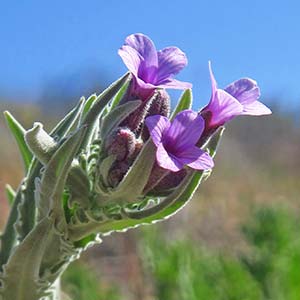|
|
ashy rock-cress, Klamath rockcress
|
| Perennials; short-lived; sexual; caudex not woody. |
Perennials; long-lived; sexual; caudex woody (often with persistent, crowded leaf bases). |
1–3 per caudex branch, arising laterally proximal to sterile shoots near ground surface, ca. 2.5 dm, densely pubescent proximally, trichomes simple and 2-rayed, 0.25–0.7 mm, glabrescent distally. |
usually 1 per caudex branch, arising from center of rosette near ground surface, 1–4(–5) dm, densely pubescent proximally, trichomes short-stalked, 2–6-rayed, 0.1–0.2 mm, sparsely pubescent distally. |
blade oblanceolate to obovate, 2.5–5 mm wide, margins entire, ciliate along petiole, trichomes (simple), to 1 mm, surfaces densely pubescent, trichomes simple and short-stalked, 2- or 3-rayed, 0.25–0.5 mm. |
blade narrowly oblanceolate, 1–4(–5) mm wide, margins prominently dentate to subpinnatifid (leaf margins of sterile shoots often entire), ciliate near petiole base, trichomes (simple or 2-rayed), 0.4–0.6 mm, surfaces densely pubescent, trichomes short-stalked, (2–)4–9-rayed, 0.05–0.2 mm. |
4–6, not concealing stem; blade auricles ca. 1 mm, surfaces of distalmost leaves sparsely pubescent. |
(10–)20–60, often concealing stem throughout; blade auricles 0.5–3 mm, surfaces of distalmost leaves moderately to sparsely pubescent. |
6–10-flowered, unbranched. |
8–30-flowered, usually unbranched. |
ascending at anthesis; sepals pubescent; petals lavender, 4–5 × 1–1.5 mm, glabrous; pollen ellipsoid. |
divaricate-ascending to pendent at anthesis; sepals pubescent; petals usually purple, rarely lavender, 9–14 × 1.5–3 mm, glabrous; pollen ellipsoid. |
ascending, straight, 6–10 mm, glabrous or sparsely pubescent, trichomes subappressed, branched. |
reflexed, strongly recurved, 5–15 mm, pubescent, trichomes appressed, branched. |
divaricate-ascending, not appressed to rachis, not secund, slightly curved, edges parallel, 4–5 cm × ca. 1 mm; valves glabrous; ovules ca. 64 per ovary; style ca. 0.2 mm. |
pendent, not appressed to rachis, not secund, straight to slightly curved, edges parallel, (3.5–)5–8 cm × (1.6–)2–3 mm; valves pubescent throughout; ovules 24–42 per ovary; style 0.5–1 mm. |
uniseriate, (none mature). |
uniseriate, 2.5–3.5 × 1.5–2.2 mm; wing continuous or at both ends, 0.4–0.8 mm wide. |
|
= 14. |
|
|
|
|
| Flowering May. |
Flowering Mar–May. |
| Basalt outcrop in pinyon-juniper woodlands |
Rock outcrops, talus, gravelly soil, often in sagebrush-grassland communities |
| ca. 2100 m (ca. 6900 ft) |
800-2400 m (2600-7900 ft) |
|
NM |
CA; ID; NV; OR; UT
|
Boechera villosa is known only from the type collection from the Rio Grande Gorge in Taos County. The holotype was originally identified as Arabis (Boechera) perennans but clearly is more closely related to B. pallidifolia (see M. D. Windham and I. A. Al-Shehbaz 2006 for detailed comparison). (Discussion copyrighted by Flora of North America; reprinted with permission.) |
Originally thought to be restricted to northern California and adjacent Oregon, Boechera subpinnatifida is a sexual species that recently has been found in central Idaho, northern Nevada, and northwestern Utah. It appears to intergrade with both B. puberula and B. retrofracta, and species boundaries within this complex need further study. (Discussion copyrighted by Flora of North America; reprinted with permission.) |
| FNA vol. 7, p. 411. |
FNA vol. 7, p. 409. |
| Brassicaceae > tribe Boechereae > Boechera |
Brassicaceae > tribe Boechereae > Boechera |
B. acutina, B. arcuata, B. atrorubens, B. bodiensis, B. breweri, B. burkii, B. calderi, B. californica, B. canadensis, B. cascadensis, B. cobrensis, B. collinsii, B. consanguinea, B. constancei, B. covillei, B. crandallii, B. cusickii, B. davidsonii, B. dentata, B. depauperata, B. dispar, B. divaricarpa, B. drepanoloba, B. duchesnensis, B. elkoensis, B. evadens, B. falcatoria, B. falcifructa, B. fecunda, B. fendleri, B. fernaldiana, B. formosa, B. fructicosa, B. glareosa, B. glaucovalvula, B. goodrichii, B. gracilenta, B. gracilipes, B. grahamii, B. gunnisoniana, B. harrisonii, B. hastatula, B. hoffmannii, B. holboellii, B. horizontalis, B. howellii, B. inyoensis, B. johnstonii, B. koehleri, B. laevigata, B. languida, B. lasiocarpa, B. lemmonii, B. lignifera, B. lincolnensis, B. lyallii, B. macounii, B. microphylla, B. missouriensis, B. nevadensis, B. ophira, B. oxylobula, B. paddoensis, B. pallidifolia, B. parishii, B. pauciflora, B. paupercula, B. peirsonii, B. pendulina, B. pendulocarpa, B. perennans, B. perstellata, B. pinetorum, B. pinzliae, B. platysperma, B. polyantha, B. porphyrea, B. pratincola, B. puberula, B. pulchra, B. pusilla, B. pygmaea, B. quebecensis, B. rectissima, B. repanda, B. retrofracta, B. rigidissima, B. rollei, B. rollinsiorum, B. rubicundula, B. saximontana, B. schistacea, B. serotina, B. serpenticola, B. shevockii, B. shockleyi, B. sparsiflora, B. spatifolia, B. stricta, B. subpinnatifida, B. suffrutescens, B. texana, B. tiehmii, B. tularensis, B. ultra-alsa, B. williamsii, B. xylopoda, B. yorkii |
B. acutina, B. arcuata, B. atrorubens, B. bodiensis, B. breweri, B. burkii, B. calderi, B. californica, B. canadensis, B. cascadensis, B. cobrensis, B. collinsii, B. consanguinea, B. constancei, B. covillei, B. crandallii, B. cusickii, B. davidsonii, B. dentata, B. depauperata, B. dispar, B. divaricarpa, B. drepanoloba, B. duchesnensis, B. elkoensis, B. evadens, B. falcatoria, B. falcifructa, B. fecunda, B. fendleri, B. fernaldiana, B. formosa, B. fructicosa, B. glareosa, B. glaucovalvula, B. goodrichii, B. gracilenta, B. gracilipes, B. grahamii, B. gunnisoniana, B. harrisonii, B. hastatula, B. hoffmannii, B. holboellii, B. horizontalis, B. howellii, B. inyoensis, B. johnstonii, B. koehleri, B. laevigata, B. languida, B. lasiocarpa, B. lemmonii, B. lignifera, B. lincolnensis, B. lyallii, B. macounii, B. microphylla, B. missouriensis, B. nevadensis, B. ophira, B. oxylobula, B. paddoensis, B. pallidifolia, B. parishii, B. pauciflora, B. paupercula, B. peirsonii, B. pendulina, B. pendulocarpa, B. perennans, B. perstellata, B. pinetorum, B. pinzliae, B. platysperma, B. polyantha, B. porphyrea, B. pratincola, B. puberula, B. pulchra, B. pusilla, B. pygmaea, B. quebecensis, B. rectissima, B. repanda, B. retrofracta, B. rigidissima, B. rollei, B. rollinsiorum, B. rubicundula, B. saximontana, B. schistacea, B. serotina, B. serpenticola, B. shevockii, B. shockleyi, B. sparsiflora, B. spatifolia, B. stricta, B. suffrutescens, B. texana, B. tiehmii, B. tularensis, B. ultra-alsa, B. villosa, B. williamsii, B. xylopoda, B. yorkii |
|
Arabis subpinnatifida |
| Windham & Al-Shehbaz: Harvard Pap. Bot. 11: 86. (2006) |
(S. Watson) Al-Shehbaz: Novon 13: 389. (2003) |
| |
CA,
OR
CalFlora,
CalPhotos,
Flora NW,
PNW Herbaria
WildflowerSearch
iNaturalist (observations)
